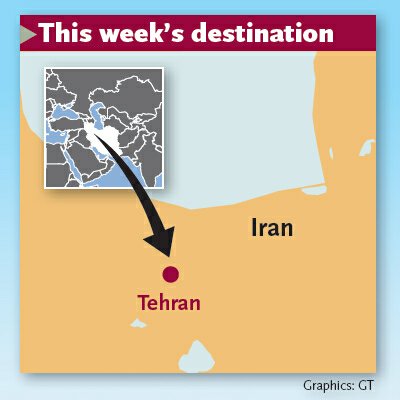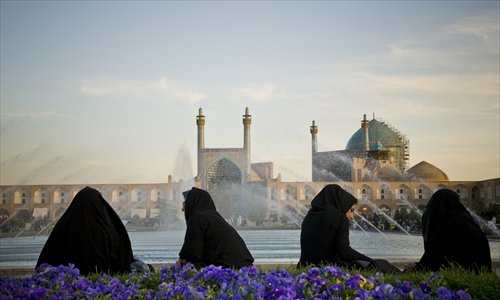Discover an ancient land of cultural shifts and Persian gifts

This week's destination

Women are sitting at the Imam Square of Isfahan, Iran. Photo: IC
"Please don't worry about the fare, you can pay me next time!" said the driver as our taxi pulled up to my hotel in Tehran, much to my disbelief. I was staying in Tehran for only one day; I didn't know if there would be a "next time."
"He doesn't really mean it," explained Madi with a smile, " he's just being polite."
Madi, my Iranian friend and travel companion for the next two weeks, had just introduced me to the fantastic world of Taarof. Possibly one of the most endearing aspects of Iranian hospitality, Taarof is a practice where the only goal is to leave everyone you encounter during your day with a smile on their face.
My direct flight from Rome landed at Tehran's Imam Khomeini International Airport at midnight, and once inside the taxi I started scanning the city in awe; the lit up mosques, tapering Milad Tower and welcoming Azadi Tower that marks the cities western entrance.
Led to believe I was embarking on a experiential yet relaxing vacation, I was unaware that Madi had planned a roller coaster-style trip instead. On the very evening of my arrival, we discussed our itinerary long into the night over a cup of black tea from Madi's hometown Lahijan, located in Gilan Province on the border with Azerbaijan.
An early start the next morning took me on my first adventure, which involved immersing myself among the crowds of Tehran's vibrant local bazaar. The bazaar itself was a bustle of frenzied workers, customers, shop assistants and carriages carrying merchandise back and forth along the narrow alleys of the market. The best starting point to appreciate local life in Tehran is undoubtedly the city's bazaar, with its heaving market proving a great choice for both delving into the country's society and sourcing ingredients for my cosmopolitan kitchen. From black tea to saffron to even the little mortars essential to grind the precious spices, the market had it all.
Tehran's bazaar is considered not only the heart of the capital but of the whole country, the sort of place where all ethnic groups living in Iran meet and work together everyday. It sees a variety of different professions running side by side, from shopkeepers and boys haggling with customers, to the random man picking his way through the thousands of stalls with an old device playing muezzin's call to prayer.
East Azerbaijan and Gilan
As lively and tempting as Tehran might be, my round-Iran adventure was to begin on the second day with a night train north to Tabriz, the capital of East Azerbaijan Province, heart of Azeri culture. Nestled in the valley of Quri River between Eynali and Sahand Mountains, about 1,350 meters from sea level, Tabriz's craggy geographic features and wild weather conditions can be severe both in summer and winter. This proneness to seismic events has made the residents tough and practical, but by no means less hospitable than the rest of their fellow countrymen: a Tabrizi woman we met on the train even invited us to stay at her house upon arrival.
A picturesque old district, Iran's oldest bazaar and the glamorous El-G?lü park make for a lovely walk, but if you have the time for one single attraction in Tabriz, it should be its beautiful Blue Mosque, or what remains of its. This elegant building, commissioned by Jahan Shah in 1465, was heavily damaged by an earthquake in 1779, a catastrophic event that took the lives of some 10,000 people. Today, it is still possible to visit part of the finely decorated indigo interior that stands beyond the painfully wounded veneer of blue tiles painted with yellow flowers and Arabic scripts.
Tabriz's dry heat faded away as we gradually approached the further northern province of Gilan, mostly famous for its tea fields, lush vegetation and humid weather. Lapped by the turquoise waters of the Caspian Sea, Gilan is surrounded by unspoiled forests and blessed by fertile lands.
Life goes on serenely in Gilan, with one of the main cities, Lahijan, resembling that of a European town in central Italy. It was among the evergreen trees of Gilan's lush forests that I had my very first experience of an Iranian-style picnic. A very serious matter in local society, there is even a national day devoted to picnics every year in early April, falling on the thirteenth day of the Persian year. A good occasion to share homemade food with one another, to leave an Iranian picnic after lunch would be to miss out on the real occasion, as the hours of chatting and playing games that proceed the meal are what real picnicking is all about.
Shiraz, a stroll in ancient Persia
The peace you can breathe in Gilan Province, is only to be surpassed by the city of Shiraz, the capital of Fars Province, where "relax" and "laze" seem to be the area's watchwords. After all, this is the city of poets and nightingales, the best place if you need some time off. Not that taking a break was on schedule for Madi and I, but much to my happiness, even the wildest ride in Shiraz can become a soothing stroll.
Pastel hues, fresh flowers, little traffic and cheerful people were only some of the ingredients that made Shiraz a very pleasant stop in the journey. Two days were by no means enough though, and I was sad to only briefly enjoy the atmosphere of simply wandering its streets and visiting its attractions.
Our first day in Shiraz was devoted to Persepolis, the ceremonial capital of the Achaemenid Empire. Founded by Darius the Great around 515 BC, its monumental pillars, fine carvings and majestic lions were enough to spark my own passion for history. A visit to the Tomb of Cyrus the Great, founder of the Achaemenid Empire was equally impressive. The tomb, which is considered the most important monument of Pasargadae, the ancient capital of the empire, is about a half an hour drive from Persepolis.
The whole archaeological area of Pasargadae, including its illustrious mausoleum, was declared a UNESCO World Heritage Site in 2004, while Persepolis itself was listed in 1979.
After exploring ancient Persia, we headed back to modern Iran, embodied for us by Shiraz less than an hour drive away. Even though it is famous for its precious glimpse on the Persian empire and pre-Islamic Iran, Shiraz's sensitivity to beauty and decorative art led me to the elegant mosque of Nasir al-Mulk, creation of the Qajar Dynasty. Also known as the Pink Mosque, Nasir al-Mulk's mosque is distinctive for its gentle design and rose shades, that translate into a chimerical interplay of colorful lights shimmering on the tightly woven Persian carpet through the glass windows.
Isfahan, 'Half of the World'
Isfahan might not be as relaxing as Shiraz, but it certainly doesn't lack in elegance or sophisticated buildings; beauty that has earned the city the flattering nickname of Half of the World. The right place to begin if you want to better appreciate Isfahan's culture, is the famous Imam Square in the heart of the city, which at night offers an unmatched scenery of flickering lights reflected on the calm waters of the central pool.
We decided to start our tour from the Sheikh Lotf Allah Mosque, a masterpiece of the Safavid architecture defined by a shell-shaped dome and the absence of minarets. Its place of worship, a stunning domed chamber roofed by a finely inlaid ceiling with embellished blue and yellow ornaments, is a sight to see. As I learned, decoration of Iranian mosques recalls the patterns of Persian carpets, an art that aims to bring nature indoor. Interestingly, the only symbol never allowed inside mosques is the reproduction of animal figures.
Our second stop was the Imam Mosque, formerly known as Shah Mosque. With its maze of arches, corridors, courtyards and exquisitely decorated polychrome chambers, it is another superb example of Safavid architectural style.
Isfahan's bazaar is aptly laid out around the main square, with shops selling local and national handicrafts lined up beside one another that allow visitors to easily soak up the culture.
Last stop: Yazd
The city of Yazd was the last stop of my trip, a township famous for its windcatchers (badgirs in Persian), desert architecture and Zoroastrian past that best shows its legacy.
Very cold in winter and stifling hot in summer, Yazd is able to enchant foreigners and locals alike. My hotel, an adapted traditional house, was located in the Fahadan neighborhood, a mud-brick old district dominated by an evocative landscape of badgirs with a yesteryear atmosphere. The local Grand Mosque, Zoroastrian Fire Temple and Dolat Abad, are the highlights of a town that is still managing to retain much of its authentic charm. With a considerably more chador spotted than in other cities, Shiraz is a more traditional and conservative community.
I was aware from the start of my trip that the size and diversity of Iran meant it would be impossible for me to visit all the places I had in mind, but, as my friend Madi would say after every sight we couldn't include in our schedule: "next time!"
Rules of thumb
Practical information: The local currency in Iran is the Iranian Rial. Due to economic sanctions, Iranian ATMs are not connected with any international banking circuits, making it impossible for foreign tourists to withdraw money directly from the bank. The best and easiest way is to bring the cash you will need and exchange it into the local currency.
What to say: The official language is Farsi (Persian), with English seldom being spoken. An English speaking tour guide is advised.
When to go: Summer can be very hot especially in southern regions, while winter in the country's northern provinces is cold and snowy. Weather-wise, the best months to travel to Iran are from March to June. The Nowruz Festival, Iran's New Year according to Persian calendar, begins on March 21 for about a month, with prices of hotels and restaurants rising with the influx of tourists.
Where to stay: In Iran you can find any type of accommodation, with four-star hotel prices ranging from around $60 per night for a double room, and budget guest houses from about $15 per night for a double room.
Transportation: In Iran public transport is very efficient. Tehran is very well served by the subway and many buses, and taxi rides are not expensive. Also extra-urban public transport is well organized, with day and night buses and trains connecting the main cities one another for prices ranging from $10 to $3 depending on the distance.
Excursions: A day trip to Persepolis from Shiraz can be arranged from the hotel. A trip with a private driver to Persepolis and Pasargadae from 9 am to 5 pm would cost up to $40.
Newspaper headline: A ‘bazaar’ adventure across modern Iran